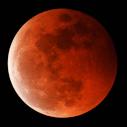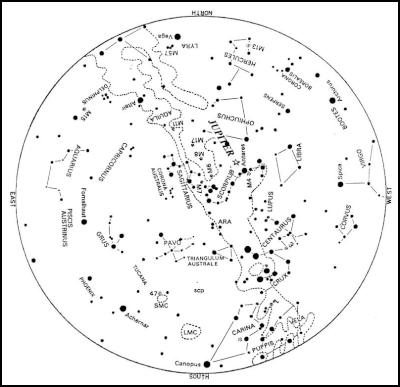Brian Carter's The Night Sky
The Night Sky
By Brian Carter *
The August Night Sky
August is the month that we really start to notice the days getting longer and the nights shorter.
 Planets
Planets
August is a poor month for viewing the planets. Jupiter and Mars will be visible for all of August. Venus will be visible in the evening sky at the start and in the morning sky at the end of the month. Saturn will be visible in the evening sky for the first few days of August and Mercury will just be visible in the evening at the very end of the month.
Venus will be visible in the Western evening sky for the first few days of August. As the days progress, it will rapidly sink lower in the evening sky until about the middle of the month it will set as the Sun sets and towards the end of the month it will reappear in the morning sky. At the start of the month it sets at 19 36 and by August 12 at 18 36,(an hour after Sunset). By August 24 it rises at 05 59 (an hour before Sunrise) and at 05 24 by month’s end. Venus starts the month in the constellation of Sextans, moving into Hydra on August 18, into Leo on August 25 for a very short stay, and finally into Cancer on August 26. It starts and ends the month at a brilliant magnitude of –4.3, fading to –4.0 in the middle of the month.
Saturn will be visible in the early evening for the first part of August. At the start of the month it sets at 18 50 and by August 7 at 18 30 (an hour after Sunset). Saturn is in the constellation of Leo, in which it remains until September 2009. Its magnitude is a constant 0.6 during the month.
Jupiter will be visible for the first two thirds of the night. At the start of the month it sets at 03 43 and at 01 49 by month’s end. Jupiter is in the constellation of Ophiuchus, in which it remains until 2007 December. Its magnitude slightly fades from –2.4 to –2.2 by the end of August.
Mars will be visible for the last quarter of the night. At the start of August it rises at 02 23 and at 01 59 by month’s end. Mars is in the constellation of Taurus. Its magnitude slightly brightens from 0.5 to 0.3 during the month.
Mercury may just be visible in the evening sky at the very end of August. By the end of the month it sets at 19 03, which is 68 minutes after Sunset. Mercury starts the month in the constellation of Gemini, moving into Cancer on August 5 and finally into Leo on August 14. It has a magnitude of –0.6 by month’s end.
All times are for Wellington unless otherwise stated. Other centres may vary by a few minutes.
Phases of the
Moon
Last Quarter – August 6 at 09 20. New Moon – August 13 at 11 03. First Quarter – August 21 at 11 54. Full Moon – August 28 at 22 35.
Lunar Eclipse on August 28 On August 28 there is a total eclipse of the Moon. This is when the Earth’s shadow falls across the Moon. As the Earth has an atmosphere, the shadow that is cast on the Moon does not have a clear cut edge so the shading will be gradual. The eclipse starts at 19 52 when the Moon enters the penumbra (partial shadow), but little change will be seen until the Moon enters the umbra (full shadow) at 20 51. The total eclipse starts at 21 52 and ends at 23 23, with maximum at 22 37. The Moon leaves the umbra at 00 24 and leaves the penumbra at 01 22.
The Moon should go a reddish colour because of the dust in our atmosphere; the more dust the redder the Moon will appear.
Below are the times of the eclipse.
Time Moon Enters Penumbra 19 52 Moon Enters Umbra 20 51 Total Eclipse Starts 21 52 Maximum Eclipse 22 37 Total Eclipse Ends 23 23 Moon Leaves Umbra 00 24 Moon Leaves Penumbra 01 22
Diary of Astronomical Phenomena
Aug
3 Venus 6°S of Regulus in evening.
4 Moon at perigee
(closest to the Earth) at 12 00. (Distance = 0.0024659 AU =
368,890 km).
7 Jupiter stationary against the background
stars at 18 00, as its motion changes from a Westerly to an
Easterly direction.
13 New Moon at 11 03.
16 Mercury
in Superior conjunction (on the far side of the Sun)at 08
00.
18 Venus in Inferior conjunction (between the Earth
and Sun) at 16 00.
19 Moon at apogee (furthest from the
Earth) at 15:00 (Distance = 0.0027047 AU = 404,620
km).
22 Saturn in conjunction with Sun (on the far side
of the Sun) at 11 00.
24 Mars close to Aldebaran in the
morning sky.
28 Full Moon at 22 35 and Lunar Eclipse (see
details above).
31 Moon at perigee (closest to the Earth)
at 12 00. (Distance = 0.0024344 AU = 364,180 km).
AUGUST SKY CHART
This chart shows the sky as it appears at about 21:00 for ~August 15.

Click to enlarge
How To Use the Sky Charts To use the sky chart hold it up to the sky so that the direction in which you are looking is at the lower edge of the map. For example, if you are looking at the western horizon then the map should be held so that the “WEST” label is at the lower edge. The altitude and direction of the stars and planets will then be correctly shown. The centre of the chart will be directly overhead.
If you would like to receive Carter Observatory’s full e-Newsletter, please email to Astronomy@carterobservatory.org to be included on the list.


 Eugene Doyle: Writing In The Time Of Genocide
Eugene Doyle: Writing In The Time Of Genocide Gordon Campbell: On Wealth Taxes And Capital Flight
Gordon Campbell: On Wealth Taxes And Capital Flight Ian Powell: Why New Zealand Should Recognise Palestine
Ian Powell: Why New Zealand Should Recognise Palestine Binoy Kampmark: Squabbling Siblings - India, Pakistan And Operation Sindoor
Binoy Kampmark: Squabbling Siblings - India, Pakistan And Operation Sindoor Gordon Campbell: On Budget 2025
Gordon Campbell: On Budget 2025 Keith Rankin: Using Cuba 1962 To Explain Trump's Brinkmanship
Keith Rankin: Using Cuba 1962 To Explain Trump's Brinkmanship